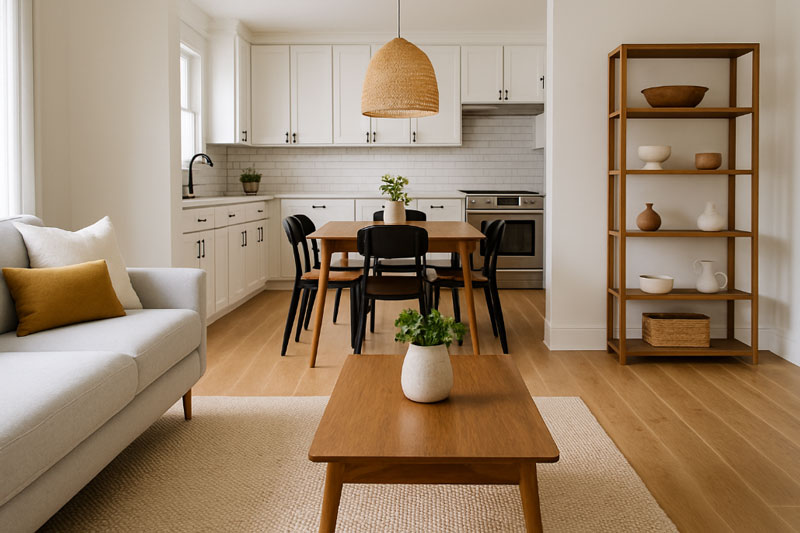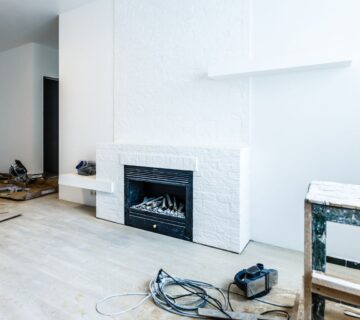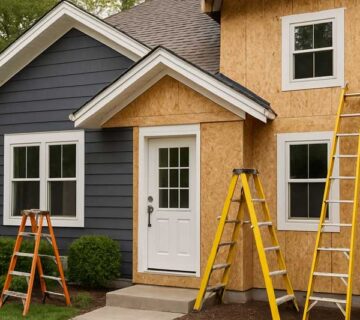Choosing the right flooring is about more than durability—it’s about design. The flooring you select has a major impact on how your home feels and flows. Matching flooring with your home’s interior style helps create a cohesive, visually pleasing environment. In this post, we’ll guide you through choosing floors that complement your space, personality, and overall aesthetic.
Why Flooring and Interior Style Must Work Together
Flooring sets the foundation for your entire design. From rustic charm to sleek modernity, it influences the atmosphere of each room. A mismatch between flooring and décor can feel disjointed. But when they work together, your home looks polished, intentional, and inviting—just like a well-designed magazine spread.
Matching Flooring to Popular Interior Styles
Modern and Minimalist Interiors
Modern interiors favor simplicity, clean lines, and a neutral palette. To complement this style, choose flooring in light oak, gray wood, or polished concrete. Matte finishes and wide planks help maintain the minimalist aesthetic. Avoid overly textured or patterned flooring that can distract from the clean look.
Traditional or Classic Styles
Traditional spaces work well with warm-toned wood floors like cherry, walnut, or mahogany. These rich tones pair beautifully with crown molding, antique furniture, and detailed trim work. Opt for a glossy or satin finish to reflect light and add a sense of refinement to your rooms.
Rustic and Farmhouse Design
Rustic homes shine with textured, distressed wood or wood-look vinyl. Shades like weathered oak or reclaimed pine enhance that cozy, lived-in feeling. These materials complement exposed beams, vintage décor, and neutral color palettes often found in farmhouse interiors. Go for wide planks and hand-scraped finishes to complete the look.
Contemporary and Eclectic Spaces
Contemporary styles mix bold design with functional layouts. Flooring options like light-toned hardwood, terrazzo, or large-format tile suit this aesthetic well. For eclectic spaces, feel free to get creative—mix materials or use bold tile patterns in small doses. Just keep colors and textures consistent with surrounding décor.
Coastal and Beach-Inspired Designs
Coastal homes benefit from bright, airy floors that mimic sun-bleached wood or sand. White oak, light maple, or bleached vinyl plank flooring fits this look perfectly. These choices pair well with white or pastel walls, linen fabrics, and natural accents like jute rugs or driftwood.
Room-by-Room Flooring Tips
Living Room
The living room sees high traffic and sets the tone for your home. Choose flooring that matches both your design style and your lifestyle. For comfort and warmth, hardwood with area rugs is a great choice. If durability is a concern, luxury vinyl plank or engineered wood provides similar aesthetics with easier maintenance.
Kitchen
For kitchens, focus on function without sacrificing style. Match your flooring to cabinets and countertops. Use tile or waterproof vinyl for easy cleaning. Light-colored flooring works well in small kitchens to keep the space open and bright. In large kitchens, darker tones can add contrast and depth.
Bedroom
Bedrooms are more private and relaxed. Carpet adds warmth and sound insulation but isn’t the only option. If you prefer hardwood or laminate, soften it with a stylish area rug. Match flooring to your bedroom’s furniture tones—whether light, rustic, or elegant—for a balanced, calming space.
Bathroom
Bathrooms require moisture-resistant flooring. Tile is the go-to, but luxury vinyl or waterproof laminate are rising in popularity. To match your bathroom’s style, choose tile patterns or tones that echo your vanity, wall colors, or fixtures. Marble-look tiles work well in elegant spaces, while neutral textures fit minimalist designs.
Flooring Finishes and Color Considerations
Warm vs. Cool Tones
Always consider the color temperature of your flooring. Cool-toned flooring (grays, pale ash) works best with cool wall colors like blue or green. Warm tones (oak, cherry, golden brown) go well with beige, taupe, or cream interiors. Matching tones creates a soothing and harmonious space.
Light vs. Dark Flooring
Light flooring can make a room feel larger and brighter, ideal for smaller or dim spaces. Dark flooring, on the other hand, adds richness and can ground a large open-concept area. Use contrast with furniture and walls to maintain balance. Too much dark can feel heavy, while too much light may feel bland.
Mistakes to Avoid
Following Trends Blindly
Trends come and go. A flooring choice that’s “in” now may feel outdated in a few years. Instead of choosing based solely on trends, focus on timeless materials and colors that reflect your personal style and work with your home’s structure.
Mixing Too Many Flooring Types
Each room can have its own personality, but avoid clashing materials. Transitions between rooms should feel intentional. Use consistent tones and finishes, especially in open-concept layouts. If mixing materials is necessary, keep it limited to 2–3 styles and ensure they blend smoothly.
Overlooking Practicality
Beautiful floors are great—but if they scratch easily, retain moisture, or don’t fit your daily life, you’ll regret the decision. Always consider lifestyle needs such as pets, children, or high traffic. Balance aesthetics with durability to ensure your floors look good and perform well over time.
Conclusion
Matching flooring with your home’s interior design is more than a visual decision—it’s about creating harmony, comfort, and flow. With the right combination of material, tone, and texture, you can elevate every room. Choose smartly and your floors will reflect the personality and style you want your home to show.






No comment